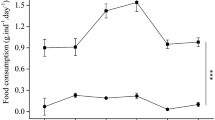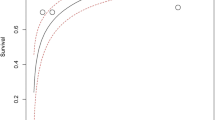Abstract
The biology of the rotifer Brachionus plicatilis has been studied extensively in recent years, due to its importance in aquaculture. Today, the culture of several marine fish species relies completely on the daily production of live rotifers.
In the present paper we explore the conditions that facilitate maintaining live rotifers for extensive periods at low temperatures. In addition to its possible contribution in providing reserve stocks for commercial application, these studies may be of ecological importance. They could explain some of the physiological adaptive mechanisms that are involved in the survival of rotifers under adverse environmental conditions.
Experimental results showed relatively high survival rates (82–85%) in rotifers that were cultured at 25 °C and exposed later to -1 °C for 12–14 days. During this period, rotifers were kept without food and their media were not changed. The survival was found to depend on the rotifer culture conditions, prior to exposure to -1 °C. These included the type of food fed to rotifers (yeast or algae), the salinity in which they were cultured, and an essential acclimation period of 2–6 day at 4 °C or 10 °C. The acclimation period was associated with the synthesis of at least one specific protein and accumulation of lipids. Profiles of protein synthesis in rotifers incubated at 10 °C revealed a 94 kD protein, which did not appear in rotifers cultured at 25 or 37 °C. Immunoisolation, using a polyclonal antibody that was prepared against HSP60, revealed that this protein was synthesized in rotifers kept at 10, 25 or 37 °C. However, this antibody did not react with the 94 kD peptide.In addition, rotifers kept at 10 °C accumulated substantial amounts of lipids, including eicosapentaenoic acid (EPA), which is found in the algae fed to them. These results support the hypothesis of specific adaptations to survival at low temperatures during an acclimation period.
Similar content being viewed by others
References
Ben-Amotz, A., R. Fishler & A. Schneller, 1987. Chemical composition of dietary species of marine unicellular algae and rotifers with emphasis on fatty acids. Mar. Biol. 95: 31–36.
Berghahn, R., S. Euteneuer & E. Lubzens, 1990. High density storage of rotifers (Brachionus plicatilis) in cooled and undercooled water. Eur. Aquacult. Soc. Spec. Publ. 11 267–274.
Bidwell, C. A., K. J. Kevin, E. Severud, S. I. Doroshov & D. M. Carlson, 1991. Identification and preliminary characterization of white sturgeon (Acipenser transnwntanus) vitellogenin mRNA. Gen. Comp. Endocrinol. 83: 415–424.
Cochrane, B. J., R. B. Irby & T. W. Snell, 1991. Effects of copper and tributyltin on stress protein abundance in the rotifer Brachionus plicatilis. Comp. Biochem. Physiol. 98C: 383–390.
Franks, F., 1985. Biophysics and Biochemistry at Low Temperatures. Cambridge University Press, Cambridge, 385 pp.
Franks, F. & R. H. M. Hatley, 1992. Protein stability under conditions of deep chill. Adv. in Low-temperature Biology 1: 141–179.
Fulks, W. & K. L. Main (eds), 1991. Rotifer and Microalgae Culture Systems. Proc. US-Asia Workshop, Honolulu, Hawaii, January 1991. The Oceanic Institute, 369 pp.
Hagiwara, A. & K. Hirayama, 1993. Preservation of rotifers and its application in the finfish hatchery. TLM Conference Proceedings No. 3, Lee, C. S., M. S. Su & I. C. Liao (eds), Pingtung, Taiwan, 252 pp.
Hino, A. & R. Hirano, 1977. Ecological studies on the mechanism of bisexual reproduction in the rotifer Brachionus plicatilis. II Effect of cumulative parthenogenetic generation on the frequency of bisexual reproduction. Bull. Jap. Soc. Sci. Fish. 43: 1147–1155.
Hirata, H., 1980. Culture methods of the marine rotifer Brachionus plicatilis. Min. Rev. Data File Fish. Res. 1: 27–46.
Hirayama, K., 1990. A physiological approach to problems of mass culture of the rotifer in marine farming and enhancement. NOAA Tech. Rep. NMFS 85, A. K. Sparks (ed.), U.S. Department of Commerce, U.S.A. 127 pp.
Jones, P. G., R. A. Van Bogelan & F. C. Neidhardt, 1987. Induction of proteins in response to low temperature in Escherichia coli. J. Bacteriol. 169: 2092–2095.
Khayat, M., E. Lubzens, A. Tietz & B. Funkenstein 1994. Cellfree synthesis of vitellin in the shrimp Penaeus semisulcatus (de Haan). Gen. and Comp. Endocr. 93: 205–213.
Lubzens, E., 1981. Rotifer resting eggs and their application to marine aquaculture. European Maricult. Soc., Spec. Publ. 6: 163–179.
Lubzens, E., 1987. Raising rotifers for use in aquaculture. Hydrobiologia 147 (Dev. Hydrobiol. 42): 245–255.
Lubzens, E., 1989. Possible use of rotifer resting eggs and preserved live rotifers (Brachionus plicatilis) in aquaculture. Aquaculture — A Biotechnology in Progress, N. De Paul, E. Jaspers, H. Ackeford & N. Wilkins (eds), Eur. Aquacult. Soc. 741–750.
Lubzens, E., R. Fishler & V. Berdugo-White, 1980. Induction of sexual reproduction and resting egg production in Brachionus plicatilis reared in seawater. Hydrobiologia 73 (Dev. Hydrobiol. 1): 55–58.
Lubzens, E., A. Marko & A. Tietz, 1985. De novo synthesis of fatty acids in the rotifer, Brachionus plicatilis. Aquaculture, 47: 27–37.
Lubzens, E., G. Kolodny, B. Perry, N. Galai, R. Sheshinski & Y. Wax, 1990. Factors affecting survival of rotifers (Brachionus plicatilis O. F. Muller) at 4 °C. Aquaculture 91: 23–47.
Lubzens, E., B. Perry, S. Beddig & R. Berhahn, 1990. Preservation of rotifers for use in aquaculture. Eur. Aquacult. Soc. Spec. Publ. 11: 233–249.
Olsen, Y, K. I. Reitan & O. Vadstein, 1993. Dependence of temperature on loss rates of rotifers, lipids and ω3 fatty acids in starved Brachionus plicatilis cultures. Hydrobiologia 255/256 (Dev. Hydrobiol. 83): 13–20.
Russel, N. J., 1990. Cold adaptation in microorganisms. Phil. Trans. r. Soc. Lond. B 326: 595–611.
Sargent, J., R. G. Henderson & D. R. Tucher, 1989. The Lipids In Fish Nutrition p. 153–218, J. E. Halver (ed.), Academic Press: 153–218.
Snell, T. W. & F. H. Hoff, 1988. Recent advances in rotifer culture. Aquaculture Magazine, September/October, 1988: 41–45.
Sukenik, A., Y. Carmeli & T. Berner, 1989. Regulation of fatty acid composition by irradience level in the eustigmatophyte Nannochloropsis sp. J. Physol. 25: 686–692.
Whyte, J. N. C. & W. D. Nagata, 1990. Carbohydrate and fatty acid composition of the rotifer, Brachionus plicatilis, fed monospecific diets of yeast or phytoplankton. Aquaculture 89: 263–272.
Thomashow, M. F., 1993. Gene induced during cold acclimation in higher plants. Adv. in Low-temperature Biology 2: 183–210.
Author information
Authors and Affiliations
Rights and permissions
About this article
Cite this article
Lubzens, E., Rankevich, D., Kolodny, G. et al. Physiological adaptations in the survival of rotifers (Brachionus plicatilis, O. F. Müller) at low temperatures. Hydrobiologia 313, 175–183 (1995). https://doi.org/10.1007/BF00025948
Issue Date:
DOI: https://doi.org/10.1007/BF00025948




